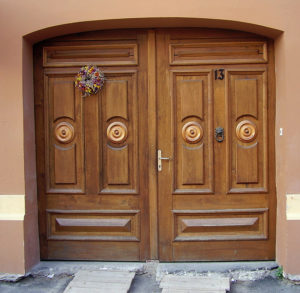There are many precautions you can take to boost your home security and ensure that your home is safer. In this short post we’ll cover 3 simple and effective ways to strengthen your doors, including: reinforcing the strike plate, improving the locks and securing your door hinges.

Image Source: Flickr
Reinforcing the Strike Plate
To further reinforce the doorjamb, install a new plate in place of the old lip strike plate that serves the doorknob lockset. Attach it with 3-in. screws. Make sure the screwheads seat flush with the face of the strike plate. We used No. 8 x 3-in. screws. No. 10 x 3-in. screws (used for the deadbolt plate) were too large. Remember to angle the screws back slightly to be sure to catch the framing (Figure A). Again, you may have to chisel a slightly larger mortise and predrill to drive the screws.
Remove the lockset’s lip strike plate and 3/4-in. screws. Predrill and attach a new plate with No. 8 x 3-in. screws that are angled in slightly to catch the stud. Predrill with a 1/8-in. bit. Source:FamilyHandyman
Improving the Locks
In a significant percentage of burglaries, the criminal enters the victim’s home through an unlocked door. Even the strongest locks in the world are useless if you don’t use them. Lock all exterior doors whenever you go out – even if you’ll just be gone a few minutes.
Install deadbolt locks. With the exception of sliding doors, all exterior doors should have a deadbolt lock in addition to the lock built into the doorknob. The deadbolt should be high quality (grade 1 or 2, solid metal with no exposed screws on the exterior), with a throw bolt (the bolt that comes out of the door) at least 1 inch (2.5 cm) long. The lock should be properly installed. Many homes have lower quality deadbolts or throw bolts less than 1 inch (2.5 cm). These must be replaced.
Install a dead-lock. Adding an additional lock will provide extra security when you are home. The dead-lock, sometimes called an ‘exit-only deadbolt’ is a deadbolt that does not have an external key. It may be clearly visible on the door from the outside, but it cannot be broken into without destroying the door, frame, or lock itself. While this security won’t help directly when you aren’t home, its visibility may discourage an intruder from trying the door. Source: wikiHow
Securing Door Hinges
The hinges of a door are an essential part of the door that connects the door to the jamb. Most residential doors have hinges that are inward facing, because the door opens up inwards. Most of these standard residential doors can withstand attacks against the hinges of the door because burglars and intruders cannot gain access to them. However, not all doors work in the same fashion. For doors that open outwards, the hinges are usually placed on either the left or right of the doors exterior and this they are easily accessible by whoever is on the outside. If the hinges on your door are compromised, it will be relatively easy for burglars to knock your door of the hinges and gain entry to your home.
The hinges of your door can be secured by using safety studs, corrugated pins, and by using setscrews in your hinges. These are all minor additions to your hinges, which will go a long way to help strengthen your door and keep your family safe. The additions are simple and effective but because of how important the hinges are to the door, it is best to make sure that nothing goes awry and that your doors are made as secure as possible. Source: SafeWise



